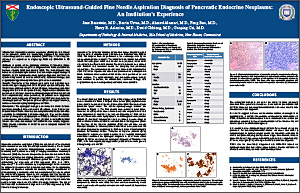Endoscopic Ultrasound-Guided Fine Needle Aspiration Diagnosis of Pancreatic Endocrine Neoplasms: An Institution’s Experiences
Jane Bernstein, M.D., Berrin Ustun, M.D., Ahmed Alomari, M.D., Fang Bao, M.D., Harry R. Aslanian, M.D., David Chhieng, M.D., Guoping Cai, M.D.
Departments of Pathology and Internal Medicine, Yale School of Medicine, New Haven, CT, USA
ABSTRACT
Introduction: Approximately 10% of patients diagnosed with low-grade squamous intraepithelial lesion (LSIL) will progress to high-grade squamous intraepithelial lesion (HSIL), 60% will regress to normal and 30% will remain. Deciding which subset of patients with LSIL who would benefit from more aggressive follow up, i.e. colposcopy/biopsy, is the key. It has been postulated that the gain of 3q26 is associated with LSIL progression to cervical intraepithelial neoplasia (CIN) 2/3 and invasive squamous carcinoma. The pur-pose of this study is to correlate high-risk (hr) human papillomavirus (HPV) viral load (VL) results and histologic follow up with the status of 3q26 gain in patients with LSIL and ASC-US (hrHPV positive [+]) Pap test interpretations.
Materials and Methods: Between October 2011 and September 2012, 80 patients who had an index cytologic interpretation of LSIL or ASCUS-hrHPV+ were tested for gain in 3q26. Only ThinPrep Pap tests (Hologic, Marlboro MA) were included in the current study. hrHPV status (by hybrid capture (HC) II; Qiagen, Germantown MD) was available in 48 patients; hrHPV viral load results were reported as very low, low, moderate, and high. Additional ThinPrep slides were prepared and tested for the chromosome 3q26 region using Oncofish (Ikonisys, New Haven, CT), an automated qualitative fluorescent in situ hybridization (FISH) test. hrHPV DNA viral load data, 3q26 FISH results and histologic cervical biopsy data were reviewed.
Results: The average age of the patients in this study was 35 years (range 17-76 years). The majority 71/80 (89%) of the cases in this study were negative for 3q26 gain. Of the 3q26 gain negative cases with hrHPV data, 38 were hrHPV positive (38/42; 90%), and half of these had a moderate or high viral load (Table 1). Additionally, the majority of 3q26 gain positive cases with hrHPV data were positive for hrHPV (5/6, 83%). All patients with available follow up data who tested positive for 3q26 gain were found to have CIN 1 or 2+ on biopsy (4/4; Table 2). On the other hand, 6 out of 24 (25%) patients with available follow up who tested negative for 3q26 gain had CIN 2+ on subsequent biopsy (Table 2).
Conclusion: A positive 3q26 gain is associated with hrHPV posi-tivity; however, there is no correlation between viral load and 3q26 status. In addition, a lack of 3q26 gain as determined by FISH did not predict the absence of CIN 2+ on subsequent follow up. Further study with greater numbers will help elucidate the role of this test in the management of low grade squamous abnormalities.
©2012 Yale Department of Pathology. All rights reserved.
Any redistribution or reproduction of part or all of the contents in any form is prohibited. You may not, except with express written permission of the author or the Department of Pathology, distribute or commercially exploit the content, nor may you transmit it or store it in any other website or other form of electronic retrieval system, including use for educational purposes.
